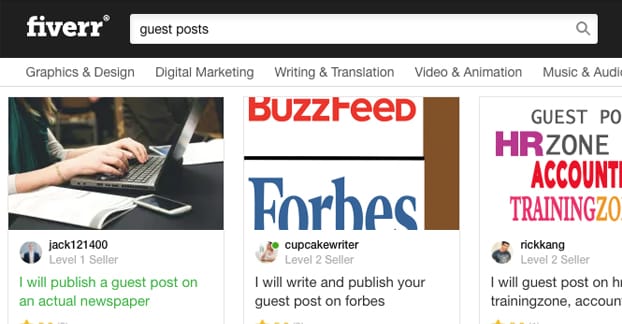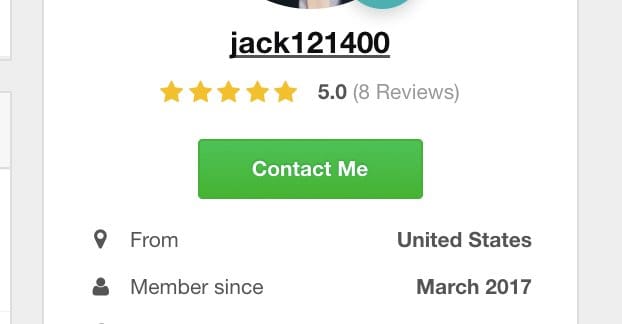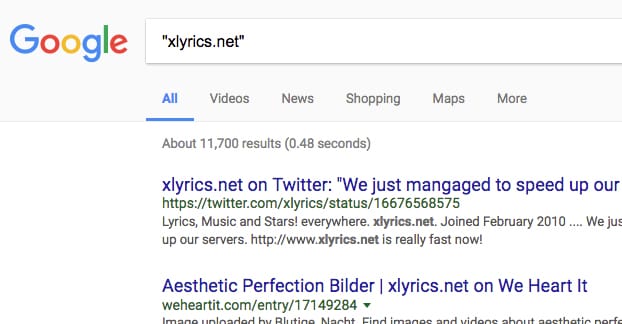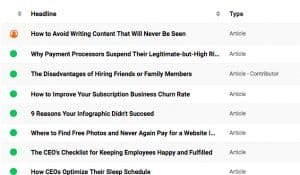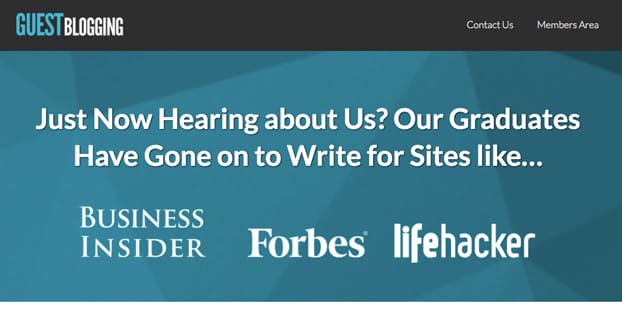Short answer: No.
Long answer: Nooooooooooo.
Real answer: Okay, let me level with you here. Fiverr exists as a place for people to sell very low effort services for a very low price. The concept of $5 for X service is sound, but then you realize that $5 is like, half an hour of minimum wage work. I don’t know what you expect out of the equivalent of a high school intern’s smoke break, but I don’t expect much.
Fiverr has tried over the years to rid themselves of their understandable reputation as a provider of crap, by allowing people to require add-ons or make gigs that get you 100 words of writing for $5, and so forth. The idea being that the $5 is not for “a blog post” it’s for 100 words of writing towards a blog post; if you want a 1,000 word blog post, you would need to buy the gig with 9 add-ons, totaling $50, a more reasonable price for a low-end freelancer’s blog writing.
So what about guest posts? When you’re buying a guest post link from Fiverr, one of two things is happening. Either the seller is creating a new blog post for a site they own or have access to, complete with a relevant topic and niche, and linking to you naturally in context of the post. OR, the seller is throwing a link of yours onto some post they have the ability to edit, sending you notification of it, and calling it good.
Which do you think is more likely for $5?
The fact is, 99% of the people selling links or guest post slots on Fiverr for $5 or $10 or what have you are doing it because they operate a PBN. A Private Blog Network, that is.
PBNs are one of those techniques that has been around for a long time and is going to continue to exist, because there’s no real way to squash it. It’s not something Google can algorithmically check, filter, and fix. They’re stuck with a two-pronged approach; they publicly tell everyone not to use PBNs through manual actions, penalties, and announcements. Then they squash the PBNs, which removes the value they had and deranks anyone who used them.
The problem with a PBN is that there’s not a lot of difference between a private blog network and a handful of blogs simply operated by the same person. If you look at the definition of a PBN in the right light, my sites could fall into the category. So could the entire Gawker network.
The difference is primarily in that a PBN sells links – generally without disclosing it or nofollowing them – to be used for boosting the SEO of the website buying the links. Gawker doesn’t do that, I don’t do that, and other networks of sites owned by the same person don’t do that.
Private blog networks also have other telltales. They often reside almost entirely on expired domains, because it’s easier to start a PBN if the domains had some residual value initially.
PBNs are almost always caught, eventually. It takes a lot of care and a lot of work to keep a PBN truly private. After all, a link is a two-way street. If I buy a link from someone, I better be able to see that link, and furthermore, Google has to see it too, or it’s valueless. Google can monitor for linking patterns in networked sites and identify the behaviors of a PBN, and take action.
A really, really good PBN can live for years, operating in a way that still provides some value; carefully vetting the sites they link to, making sure the links are on sites in their network that have some relevance, and so forth. Yet, still, Google could even just buy some links themselves, then shut down the PBN when they trace those links. It’s impossible to hide forever.
The best PBNs are truly private; they don’t sell links, they’re just used to boost the ranking of the owner’s money site. It makes them much harder to trace, and ideally by the time the PBN is shut down, the money site has grown naturally to stand on its own two legs. It’s a shortcut for the first year or so of growing a site, nothing more.
So when you buy links from a small seller on Fiverr, this is what you’re getting. You’re getting links from a PBN that, sooner or later, is going to disappear. That’s assuming it hasn’t already been hit by a manual action, but the seller just doesn’t care. After all, as long as more people are buying than are requesting refunds, they’re making a profit with zero effort.
Testing a Fiverr Link
If you don’t believe me, you can burn $5 yourself, or just contact some potential sellers directly and see what they say. Here’s what you should do.
First, contact the seller and ask them what site the links come from. Most of the gigs you’ll find don’t list the site publicly, they’ll just say “a DA 60 site” or some other nonsense. The DA here stands for Domain Authority, the Moz replacement for PageRank. It’s a number that’s meant to make you think the site is good, when Moz explicitly says it’s best used as a comparative metric, not an absolute metric.
If they ignore you, well, that seller is out of the running. If they refuse to disclose what their site is, that’s a gigantic red flag that they have something to hide. What would they do if you bought a link? Not tell you where it’s from? You wouldn’t be able to verify the purchase, so you might as well have given the local panhandler your $5 instead.
A lot of times, for this very reason, the seller will happily link you the PBN page they would use to link to you. At first glance, it probably looks like a legitimate site. So give it a bit of an overview.
- Does the site have a logo? One of the signs of a lower quality site you often find is that they’ve made little or no effort in graphic design. After all, it’s easy to set up a quick WordPress site and some text, but graphic design is harder and more expensive to commission.
- Are their graphics stolen? Sometimes a site with graphics, logo included, will have stolen it all wholesale. Do a reverse image search through something like Google Image Search or Tineye and see what comes up. If every graphic they use is a stock photo, that’s fine, but if they don’t appear to be photos the site owner has the rights to use, it might be a warning sign.
- How’s the quality of their pages look? Their homepage and the most recent blog post or two probably look good, because those are the show pieces. It’s like buying a home in new development; they have a show house put together to look nice, but the rest of them are empty or still under construction.
- Is the content itself stolen? It’s hard to tell is content is spun, but you can do a Google search for a sentence or two here and there, to see if it comes up on other URLs. You can also run it through a plagiarism checker like Copyscape.
- Is the content of reasonable quality? Pay attention to word choice, which can indicate that the writer is not a fluent English speaker, or that they used spinning software that wasn’t edited after the fact.
- Look for other links that were purchased. Chances are almost every article will only have one or two links, and those links will be to something unrelated to the topic, or only vaguely related at best. Most PBN owners aren’t concerned with content congruence, they just want the link to exist.
- Look for overall topic. Does the site have a focus, or is it some kind of “generalist” blog that has no specialization? Or does it claim to have a specialization, but publishes content all over the spectrum? These are, again, signs that the content is just stolen from wherever and used for link base, nothing more.
Any one of those is a decent reason for you to avoid getting a link from that site, but more than a couple means you should run.
The second thing you should check is whether or not the site is indexed in Google. You’ve been to the site, you should have a rough idea of how many pages and posts the site has. Often times a middling age PBN will have hundreds or thousands of blog posts, since content inflation makes a site look more legitimate.
Go to Google and put the site URL in a site search. Just search something like “site:www.thatsiteURL.com” and see what comes up. How many pages actually exist?
What comes up is what’s indexed in Google. Any page that doesn’t show up is a page that’s basically invisible. If Google doesn’t index the page, they won’t index the link, and the link you buy then has zero SEO value. If the site has 1,000 blog posts and only 15 posts indexed with Google, you can bet there’s not going to be any value to be had from buying that link.
If the site is very small and very new, it’s possible that it’s not delisted, but merely hasn’t been indexed yet. You have to weigh what you see against the seller. If the seller has 10,000 successful gigs and the site they list is brand new, how many other sites have they gone through? How long will this site last? And, of course, how much value could you possibly get out of a link on a page that didn’t exist last week?
The last thing you can check is organic traffic estimates. Without direct access to their analytics you can’t check their actual traffic, but you can use SEMRush to get an idea. Plug in the site URL and see what comes up under a traffic overview report. Does the site have any traffic? Is their traffic all from paid sources?
Most of the time, the sites you get links from on Fiverr have zero organic traffic. They might have traffic a few months ago, or a year ago, but that’s not unusual; the PBNs are set up on expired domains. It stands to reason that the site was more legitimate and had at least some traffic before it expired.
The Few and The Proud
Very rarely you will find a site that passes inspection from Fiverr for a low price, and in those causes you can cautiously invest in a few links. However, you should be aware that any site selling links will, sooner or later, lose its value. Google doesn’t want people buying links, so they frown upon the service and penalize sites that provide it.
Very rarely you will see gigs that have a base price of $150 or more, and will “publish a guest post on X site” where X site is a site you recognize. Something like the Daily Kos or Inc.
The trouble here is not that the site is bad, it’s that the author might be. They’ve done the work and gotten a guest contributor position for a big name site, and now they’re going against the terms of service for that site by selling links in their guest posts. In many cases this will eventually result in the user account being shut down. Often, all their old posts are removed or hidden. Sometimes, the sites that user linked to will be blacklisted, so not only will you lose the value of the link, you will also lose an possible publication on that site again.
Either way, I generally recommend doing the legwork yourself. Don’t try to just spend $5 and circumvent the work, because you’ll also be circumventing the value.
 ContentPowered.com
ContentPowered.com
